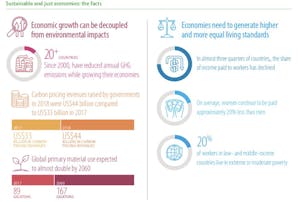A new report on the Sustainable Development Goals (SDGs) from leading experts has a clear message: The status quo is not enough to achieve the SDGs by 2030. All is not lost though. The report also outlines recommendations for how we can transform our approach to achieve the SDGs and create a more sustainable, just world for all.
To be sure, remarkable progress has been achieved in recent decades. Extreme poverty is at the lowest level recorded in human history. More children than ever are living past their fifth birthdays, going to school, and drinking clean water.
But inequality is on the rise, we are nearing catastrophic tipping points on biodiversity and climate change, and more aggressive transformations are needed to ensure a sustainable future for the 8.5 billion people expected to be on this planet in 2030, including around food, health, energy, cities, and our consumption and production.
That is the main takeaway of the new United Nations report, The Future is Now: Science for Achieving Sustainable Development. And this one is worth sitting down and reading in full. The report, also called the Global Sustainable Development Report, was compiled by 15 independent scientists around the world to offer science-based assessments and guidance about how to better forge a path toward sustainable development.
Much like the Intergovernmental Panel on Climate Change (IPCC) has powerfully put the climate emergency onto the public consciousness, this report must serve as a wake-up call that we must reduce inequalities and transform the relationship between humans and nature.

The report demonstrates that our current development model is not sustainable and that all countries need to rebalance the relationship between our social, economic, and environmental systems. The transformative progress we need to realize the SDGs will only be achieved if we approach the goals holistically and with an understanding of how they are intertwined so we can mitigate the trade-offs and build on their benefits.
Take food security, for example. Ending hunger has broad benefits across the SDGs, from health and education outcomes to labor and economic growth. But expanding our agricultural system to support a growing population has worrying environmental trade-offs, including effects on biodiversity, land degradation, water use, and greenhouse gases, which each have further implications for our climate and development agendas. Going forward, we simply cannot scale-up agriculture in the way we do it today.
Additional key recommendations from the report include the following:
Achieving the SDGs requires a systemic approach.
We need to shatter the siloed approach of working separately on the different 17 goals and move toward thinking and acting across systems. The report identifies six areas to focus on that can drive action quickly and at scale:
- Human well-being and capabilities;
- Sustainable and just economies;
- Food systems and nutrition patterns;
- Energy decarbonization with universal access to modern energy;
- Urban and peri-urban development; and
- Global environmental commons.
We must bridge the gap between scientific evidence and policy and implementation.
We have the scientific knowledge to get started, but it is not being adequately harnessed and disseminated. To make the hard choices and balance trade-offs, science must guide our decisions. The SDGs should serve as a compass for sharing existing evidence and mobilizing new research efforts, including across disciplines and fields. This will entail greater capacity building and financial support.
Transformative action needs strong political leadership and creative partnerships.
We need big action in a short amount of time, which requires leaders to make the hard, bold choices today. The report identifies four levers to achieve this change: governance, economy and finance, individual and collective action, and science and technology. While each lever alone can contribute to progress, balancing the needs of sustainable development requires collaboration across all four.
Local actors are key for implementing the SDGs.
Solutions are context specific and local knowledge and action are important. There are many pathways to sustainable development, and the SDGs give us the opportunity to connect local progress with our global ambitions.
The report pinpoints 20 solutions it believes will advance transformative progress for people and the planet. These include:
- Providing universal access to basic services like health, education, and water;
- Decoupling environmental degradation from economic growth and aligning investments with longer-term sustainability;
- Transitioning our food and nutrition systems to support good health while minimizing environmental impact;
- Reshaping the global energy system to provide universal access while transitioning to net-zero CO2 emissions; and
- Promoting people-centered and pro-poor policies and investments for livable cities.
The report’s findings will be crucial for driving conversations this month at the UN General Assembly, where heads of state and leaders from around the world and across sectors will come together for the first time since the SDGs were adopted to discuss what has been accomplished and what more is needed to deliver on the SDGs in the next decade.
The full report will be presented that week, and the summit itself will be organized around six themes that support and echo the findings of the report. It should provide more than enough resources for countries and leaders to answer the UN Secretary-General’s call to come to the summit “not with beautiful speeches, but with concrete actions, plans, and commitments.” With time speeding along, we need to secure the future of humanity and our planet now.




 View All Blog Posts
View All Blog Posts


